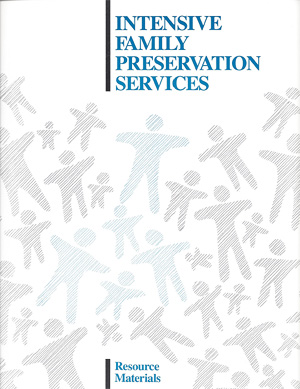
Author Archives: Peg Marckworth
2014, the 40th Anniversary of Intensive Family Preservation Services Draws to a Close
2014, the 40th Anniversary of Intensive Family Preservation Services is drawing to a close. This year has been an opportunity to look back at the beginning of Intensive Family Preservation Services, trace its growth, understand its incredible impact on child welfare and see where it is today.
2015 begins the next chapter of IFPS. We hope you join us on the IFPS Website and IFPS Blog as we document what IFPS is doing, where it is going and what we are learning.
IFPS 40TH ANNIVERSARY CELEBRATION
 In July present and past leaders in the IFPS movement from many national organizations (including Annie E. Casey Foundation, Childr
In July present and past leaders in the IFPS movement from many national organizations (including Annie E. Casey Foundation, Childr en’s Defense Fund, Child Welfare League of America, National Conference of State Legislators, Edna McConnell Clark Foundation, National Council of Juvenile and Family Court Judges) and from many states (Indiana, Louisiana, New Jersey, New York, Kentucky, Missouri, Washington) gathered in Seattle to celebrate and chronicle the history and stories of one of the most important systems reform init
en’s Defense Fund, Child Welfare League of America, National Conference of State Legislators, Edna McConnell Clark Foundation, National Council of Juvenile and Family Court Judges) and from many states (Indiana, Louisiana, New Jersey, New York, Kentucky, Missouri, Washington) gathered in Seattle to celebrate and chronicle the history and stories of one of the most important systems reform init iatives in child welfare in this country.
iatives in child welfare in this country.
Attendees shared their knowledge and experiences as the group reviewed the contribution of IFPS to child welfare, how its implementation impacted child welfare, and what it offers for the future.
 Charlotte Booth, Executive Director of the Institute for Family Development opened the IFPS 40th anniversary celebration with a welcome and shared why the IFPS initiative is so significant in child welfare:
Charlotte Booth, Executive Director of the Institute for Family Development opened the IFPS 40th anniversary celebration with a welcome and shared why the IFPS initiative is so significant in child welfare:
“We are here today to celebrate and document the most brilliantly conceived and executed system change effort I have ever seen, let alone had the honor of being part of. In fact, while I’ve been calling it an “initiative,” that’s not quite the right word. Revolution or reformation might better express the magnitude of what was done.”
She explained that this day was an opportunity to see how all the different aspects of the initiative wove together and the outcomes that make family preservation what it is today: “…we want to document this information not just to paint a picture of the past, but to create a blueprint for the new generation of child welfare leaders and policy makers…”
IFPS 40th Anniversary Remarks by Charlotte Booth
Peter Forsythe, Children’s Program Director at the Edna McConnell Clark Foundation provided leadership for the intensive family preservation initiative. Between 1985 and 1995 the Edna McConnell Clark Foundation supported intensive family preservation services helping more than 30 states adopt the Homebuilders™ model.
Peter Forsythe attended the 40th Anniversary and had this reaction: “I sat with wonder today  as I let you guys catch me up on 20 years of time in the hills and being unconnected with what’s gone on since I retired from the Clark Foundation, and it was a marvelous day to have a chance to learn these things, and I marvel at the strength and the creativity and the resilience of this team that you guys are…[This] cause has gone forward, and I’m just incredibly proud of what you have continued to do.”
as I let you guys catch me up on 20 years of time in the hills and being unconnected with what’s gone on since I retired from the Clark Foundation, and it was a marvelous day to have a chance to learn these things, and I marvel at the strength and the creativity and the resilience of this team that you guys are…[This] cause has gone forward, and I’m just incredibly proud of what you have continued to do.”
THE INTENSIVE FAMILY PRESERVATION SERVICES WEBSITE
www.intensivefamilypreservation.org

The IFPS website was launched at the July celebration. The website is designed as a resource for those interested and working in IFPS. It archives IFPS’ history and will continue to document its growth and impact.
The website includes key resources for IFPS, including a comprehensive bibliography and the 2014 Nationwide IFPS Survey Report. http://www.intensivefamilypreservation.org/resources
You can also read more about the July 40th Anniversary Celebration and see photos from the event. http://www.intensivefamilypreservation.org/resources
IFPS BLOG
www.intensivefamilypreservation.org/blog
Throughout the year the IFPS blog has highlighted both the history and the future of IFPS. Posts have covered IFPS Practice, Research, State Profiles, IFPS in Mental Health and Juvenile Justice.
Pioneers and experts in the field of family preservation services shared their thoughts, memories and wisdom—excerpted here with links to their full posts:
Jim Whittaker, Professor Emeritus, University of Washington School of Social Work:
 “What then are the defining characteristics/components of intensive family preservation services? The first is a set of values and beliefs. Variously stated and as referenced earlier, they all speak to the notion of “family” as the ideal locus for child rearing and family support. Parents are viewed collegially, crises are viewed as opportunities for change, families are presumed to be doing the best they can under difficult circumstances, and caution is urged in labeling families as untreatable. While this particular set of values originates from the Homebuilders program, perhaps the best known of all of the family preservation models, the expressed values reflect the larger and more diverse array of family preservation programs as well.”
“What then are the defining characteristics/components of intensive family preservation services? The first is a set of values and beliefs. Variously stated and as referenced earlier, they all speak to the notion of “family” as the ideal locus for child rearing and family support. Parents are viewed collegially, crises are viewed as opportunities for change, families are presumed to be doing the best they can under difficult circumstances, and caution is urged in labeling families as untreatable. While this particular set of values originates from the Homebuilders program, perhaps the best known of all of the family preservation models, the expressed values reflect the larger and more diverse array of family preservation programs as well.”
The Elegant Simplicity of Family Preservation Practice Legacies and Lessons
Judge Richard Fitzgerald:
 “As I became aware of the work of The Institute for Family Development and the Homebuilders® model I saw the model as a powerful tool to meet the constitutional requirement of “reasonable efforts” and I spent time training judges about the model. The State’s interest in child protection which requires action abuts fundamental parental rights. While I may at times have been guilty of overselling the concepts of Peter Peccora and Charlotte Booth and the usual suspects who taught me and are gathered there today, I have no mea culpa as I saw in my own community and across systems the benefits to families of keeping families together by removing the risk rather than the child.”
“As I became aware of the work of The Institute for Family Development and the Homebuilders® model I saw the model as a powerful tool to meet the constitutional requirement of “reasonable efforts” and I spent time training judges about the model. The State’s interest in child protection which requires action abuts fundamental parental rights. While I may at times have been guilty of overselling the concepts of Peter Peccora and Charlotte Booth and the usual suspects who taught me and are gathered there today, I have no mea culpa as I saw in my own community and across systems the benefits to families of keeping families together by removing the risk rather than the child.”
Judge Richard (Fitz) Fitzgerald: Reflections on the Intensive Family Preservation Initiative
Shelley Leavitt:
“I n 1994, Priscilla Martens, Director of the National Family Preservation Network (NFPN), surveyed states to gather information about statewide implementation of Intensive Family Preservation Services (IFPS). Some of you may recall that at one time, these services were called “family preservation services”—FPS, and then later (I can’t recall when), the “I”—Intensive” was added and these services became Intensive Family Preservation Services (IFPS). In some states these services are still referred to as “family preservation”, and in others, “intensive family preservation”.
n 1994, Priscilla Martens, Director of the National Family Preservation Network (NFPN), surveyed states to gather information about statewide implementation of Intensive Family Preservation Services (IFPS). Some of you may recall that at one time, these services were called “family preservation services”—FPS, and then later (I can’t recall when), the “I”—Intensive” was added and these services became Intensive Family Preservation Services (IFPS). In some states these services are still referred to as “family preservation”, and in others, “intensive family preservation”.
In 1994, the survey showed that a half dozen states had implemented IFPS/FPS statewide. This was pretty amazing. After a fairly short time—less than 8 years—statewide implementation was achieved in a number of states. This accomplishment was the direct result of Peter Forsythe’s vision and strategic approach to systems change, and the work of many of you here today, who were involved at many different levels.”
Shelley Leavitt: What’s Happening Today in IFPS and HOMEBUILDERS®
Betsy Cole:
“An yone who has ever done cutting edge work knows that it takes courage. You face your own doubts and some very hostile critics. I praise you for your strength. In the end, I suspect that strength comes from the knowledge that you are “Doing the right thing”. And doing it not for you but for others.”
yone who has ever done cutting edge work knows that it takes courage. You face your own doubts and some very hostile critics. I praise you for your strength. In the end, I suspect that strength comes from the knowledge that you are “Doing the right thing”. And doing it not for you but for others.”
Elizabeth (Betsy) S. Cole: What Family Preservation Services Mean To Me
Posted by Peg Marckworth
What’s Happening with IFPS?

As 2014 draws to a close we’d like to share with you a few new developments in the field of IFPS.
- Four IFPS programs participated in a research study released earlier this year. A key component of the projects was the development of exit instruments for both the worker and parents that were aligned with an assessment tool. Outcome of the study showed very close alignment between the worker and parent perspective when families completed services.
This is the first known research study of exit instruments completed by both the worker and the parents in IFPS programs.
To read the full research report visit: http://www.nfpn.org/reunification/reunification-research
For more information on the exit instruments visit: http://www.nfpn.org/products/exit-instruments
- 2) Continuous Quality Improvement (CQI) Instrument for IFPS. Two IFPS agencies participated in field-testing a CQI instrument for IFPS this year. The instrument is designed for use with review of case files to assess both strengths and weaknesses of IFPS programs. It covers 10 areas of best practice with over 75 items included. The National Family Preservation Network (NFPN) will release the CQI instrument and accompanying training materials in January.
- Federal and state agencies now require that trauma and well-being be addressed in child and family services. Several IFPS programs have field-tested a tool to assess trauma and post-trauma well-being. The findings from the field test are very positive with a research report in progress. NFPN will release the new trauma domains in February.
- The IFPS Nationwide Survey conducted this year revealed that very few IFPS agencies are offering field placements for IFPS (see a recent IFPS Blog post on field placements http://www.intensivefamilypreservation.org/field-placement-experiences-in-ifps/). NFPN is planning to develop an IFPS Field Placement Guide and is seeking input on best practice for field placements. If your agency offers field placements in IFPS or in other areas, please contact NFPN.
Posted by Priscilla Martens, Executive Director
National Family Preservation Network
Wishing you a Happy Thanksgiving from the IFPS Blog
We are thankful for all of you who work in Intensive Family Preservation Services and make a difference in the lives of children and families.

In 1863, President Abraham Lincoln, in a speech expressing gratitude for the Union Army’s victory at Gettysburg, announced that the nation would celebrate an official Thanksgiving Holiday on the 4th Thursday of November.
In his proclamation on October 3, 1863, President Lincoln said:
“The year that is drawing towards its close, has been filled with the blessings of fruitful fields and healthful skies. To these bounties, which are so constantly enjoyed that we are prone to forget the source from which they come, others have been added, which are of so extraordinary a nature that they cannot fail to penetrate and soften even the heart which is habitually insensible to the ever watchful providence of Almighty God. In the midst of a civil war of unequaled magnitude and severity, which has sometimes seemed to foreign States to invite and to provoke their aggression, peace has been preserved with all nations, order has been maintained, the laws have been respected and obeyed, and harmony has prevailed everywhere except in the theatre of military conflict…
Read his complete speech here:
http://www.abrahamlincolnonline.org/lincoln/speeches/thanks.htm
Posted by Peg Marckworth, Priscilla Martens and Charlotte Booth
Intensive Family Preservation Services: Resource Book
 The Family Preservation Project was a 2-year specialization in intensive family preservation services at the University of Washington School of Social Work in the early 1990s, sponsored jointly with the Institute for Family Development (neè Behavioral Sciences Institute), the parent agency of Homebuilders™ and funded by the Edna McConnell Clark Foundation.
The Family Preservation Project was a 2-year specialization in intensive family preservation services at the University of Washington School of Social Work in the early 1990s, sponsored jointly with the Institute for Family Development (neè Behavioral Sciences Institute), the parent agency of Homebuilders™ and funded by the Edna McConnell Clark Foundation.
Jim Whittaker, Emeritus Professor at University of Washington, School of Social Work explained the challenge: “could we bring the heart of Homebuilders™ into a social work curriculum here at the University of Washington School of Social Work and enhance our professional preparation of students and graduates in doing that, and would there be some ideas worth sharing with a broader audience of social work nationally?”
The Project:
- Developed and implemented a model graduate curriculum for specialization in intensive family preservation.
- Prepared a cadre of students for leadership positions in family preservation services.
- Designed a graduate-level family preservation curriculum in practice, policy, research areas.
- Facilitated research on key practice and administrative issues in the family preservation field.
In 1991 the Mandel School of Applied Social Sciences, Case Western Reserve University published Intensive Family Preservation Services: Resource Book, compiled and edited by Linda Jewell Morgan and Peg Marckworth.
With the permission of the Mandel School of Applied Social Sciences, Case Western Reserve University the handbook is reprinted on the Resources page of our website: Click here to view the handbook »
posted by Peg Marckworth
Shelley Leavitt: What’s Happening Today in IFPS and HOMEBUILDERS®
Presented at the IFPS 40th Anniversary, July 18, 2014
 I have been asked to talk briefly about what is happening today in IFPS and Homebuilders®. Those of you who know me—and many of you do—know that being brief is not my strong suit, but I will try very hard to briefly summarize the current state of IFPS/Homebuilders and some of the exciting new developments.
I have been asked to talk briefly about what is happening today in IFPS and Homebuilders®. Those of you who know me—and many of you do—know that being brief is not my strong suit, but I will try very hard to briefly summarize the current state of IFPS/Homebuilders and some of the exciting new developments.
First, however, I have to go back in time to 1994 to provide some context to what’s happening today. In 1994, Priscilla Martens, Director of the National Family Preservation Network (NFPN), surveyed states to gather information about statewide implementation of Intensive Family Preservation Services (IFPS). Some of you may recall that at one time, these services were called “family preservation services”—FPS, and then later (I can’t recall when), the “I”—Intensive” was added and these services became Intensive Family Preservation Services (IFPS). In some states these services are still referred to as “family preservation”, and in others, “intensive family preservation”.
In 1994, the survey showed that a half dozen states had implemented IFPS/FPS statewide. This was pretty amazing. After a fairly short time—less than 8 years—statewide implementation was achieved in a number of states. This accomplishment was the direct result of Peter Forsythe’s vision and strategic approach to systems change, and the work of many of you here today, who were involved at many different levels.
I want to rewind a little farther back to 1987, when New Jersey became the first state outside of Washington State to set a goal of statewide implementation of IFPS. In 1987 New Jersey began a very thoughtful and well planned implementation—beginning with four counties (rather than the entire state at once), with plans to expand over the next few years. I have fond memories of driving with Maureen Braun from Hudson County in the north to Cape May in the south for a week of hiring interviews with potential IFPS supervisors and therapists using the Homebuilders® interview role play. We didn’t have as many questions or the writing exercises we use today, but we used a very similar family “role play”. Out of that week of interviews unfortunately, we identified only one person to hire. But what we hope happened, and I think it did, was that the agencies learned more about the program and what we were looking for in potential staff, and began to understand the importance of “job fit”—the idea that it is not just a certain degree or experience that qualifies people for the IFPS job, but that factors such as values, lifestyle, and flexibility are essential for someone to “fit” with this type of job. This unusual strategy of role playing family members and seeing how applicants respond to them, and feedback helped them better understand the service and the need for job fit.
Back to today. We actually—hopefully —have improved our interview process based on years of experience, and many examples of what we might call “mis-hires”. We ask a lot more questions and gather more information, and we still do a role play—which is really the heart of the process. But now, instead of driving up and down a state, we do it with other states via Skype. We recently finished interviews via SKYPE with15 to 20 applicants in the Washington D.C. area as part of our start up process for a new team there. So, technology has become our friend, even though many of us fought it.
In 2006, the Washington State Institute for Public Policy (WSIPP) issued a report, which Ray Kirk and others here spoke about. This report focused a big spotlight on fidelity. The WSIPP report really highlighted the importance of fidelity, and resulted in placing a new focus on the Homebuilders® standards, which had been in place since the 1990s. In 2006 we (IFD) decided to focus on how we would measure these standards—what the fidelity measures would be, and the indicators that people are meeting the standards. (Asking for instance—does everything have to be 100% to meet a standard?) After a couple of years and many hours of meetings, we developed 23 standards and 17 pages of fidelity measures. We now share them with every state we work with. Some of those people are here today and they know the standards and fidelity measures very well.
The fidelity measures are really important for program implementation, as well as the other pieces: “What are our methods for measuring (the standards)? And, where are we going to get the data?” We have some data that are easy to count (e.g. number of face to face hours, response time, etc.) and a lot of data and information that are much more difficult to measure. This includes data/information/evidence of teaching, using cognitive behavioral interventions, engagement, and motivating families. We had to develop strategies to measure fidelity to the model and to help states then implement the model at the level of fidelity on which we were focused.
Moving a little forward in time. Some of you may know that for years we didn’t give permission to program/agencies to use the name Homebuilders®, because we couldn’t insure they would maintain fidelity to the model. As a result there were all kinds of creative names for IFPS and FPS programs all over the country: Home Ties, Family Ties, Family Options and about five versions of Families First.
In 2008, we began allowing other organizations to use the name Homebuilders® based on our ability—and theirs—to measure model fidelity. Today, there are 28 Homebuilders® programs/teams across the country with more being developed over the next year. Right now, there are:
- Twelve teams in Washington State including a team, through Washington’s mental health system, that is focused on trying to prevent psychiatric hospitalization and residential treatment. Monica Wafstet-Solin, one of our long-time staff members, heads up that program.
- Nine teams in the state of Indiana, which was one of the first states to be a laboratory for implementing the fidelity measures and standards.
- Four teams in Louisiana, with hopefully more on the horizon.
- Two teams in Broward County, Florida, an interesting privatization experiment that is going well.
- Washington D.C. is hopefully coming on line this month with one team and 3 more in 2015.
- A team in Connecticut just started 2 weeks ago.
- An exciting new team in northern British Columbia, which will be within a First Nations organization and serve First Nations/Aboriginal families.
- Two teams will be starting in Allegheny County, Pennsylvania later this year.
One of the tools we now have, which is instrumental in this implementation and development process—and this is why we’re now saying, “Technology is our friend,”—is a web-based client data and documentation system that has made it much easier at the program level, for therapists, supervisors, administrators, researchers, and for our consultants to always be kind of “peering” online at what people are doing—referrals, safety plans, and everything else involved in the intervention
So, we’re back now to 2014. NFPN has completed another survey that shows that there are now at least 12 states with statewide IFPS programs as well as many others that are not statewide. These states together are serving over 11,000 families.
So there has been and continues to be movement and new developments in IFPS —and it’s exciting.
Posted by Peg Marckworth
Family Preservation Services and Ebola
 On Saturday, October 18, 2014, I woke up at 8:30 AM with the thought: “What can IFPS staff do to protect themselves from this deadly disease called Ebola?” While it is pretty strange that this was the first thing that came to my mind, it makes sense to think about it as the majority of our work with the IFPS families is in their natural environment.
On Saturday, October 18, 2014, I woke up at 8:30 AM with the thought: “What can IFPS staff do to protect themselves from this deadly disease called Ebola?” While it is pretty strange that this was the first thing that came to my mind, it makes sense to think about it as the majority of our work with the IFPS families is in their natural environment.
What are the Risks for IFPS Staff?
The media attention on Ebola reminds us that it is important to educate ourselves, and in some cases, our IFPS client families about contagious diseases, how they are transmitted, and what steps we can take to protect ourselves. The majority of IFPS workers will never be in a situation that puts them at risk of Ebola but there are many highly contagious diseases that we are more likely to come in contact with: colds, flu, pneumonia, gastrointestinal diseases, pink eye and skin infections, lice, measles, mumps and chicken pox. We’re entering the flu season and the holidays are approaching. People are more likely to get sick at this time of year.
In IFPS we teach our clients strategies for prevention and we intervene as needed. These are the same steps for minimizing the spread of infectious diseases. Prevent whenever possible and seek medical intervention as needed. You can teach and model these strategies for your clients.
General Guidelines for Protection and Prevention
- Wash your hands with soap and water. When you can’t wash your hands, use hand sanitizer.
- Keep yourself and your family current on flu and other vaccinations.
- Take care of yourself: eat well, get enough sleep and take breaks when you aren’t with clients.
- Stay home if you get sick, especially if you have a fever or are vomiting.
- Pay attention to outbreaks such as norovirus or chicken pox or flu—in your own community as well as your clients’.
Another important prevention strategy is to learn if anyone in your client families has traveled overseas or has been in contact with contagious diseases such as malaria, parasites, tuberculosis, tropical diseases or Ebola.
On the Subject of Ebola…
Few, if any, IFPS workers will ever be a situation that puts them at risk of Ebola. There have been very few cases in the United States. The highest risk is for healthcare workers caring for Ebola patients and family and friends of those patients.
According to the Centers for Disease Control and Prevention (CDC): “All cases of human illness or death from Ebola have occurred in Africa (with the exception of several laboratory contamination cases: one in England and two in Russia). One travel-associated case was diagnosed in the United States on September 30, 2014. On October 12, 2014, a healthcare worker at Texas Presbyterian Hospital who provided care for the index patient has tested positive for Ebola. CDC confirms that the healthcare worker is positive for Ebola.” www.cdc.gov/vhf/ebola/exposure
“Ebola, previously known as Ebola hemorrhagic fever, is a rare and deadly disease caused by infection with one of the Ebola virus strains. Ebola can cause disease in humans and nonhuman primates (monkeys, gorillas, chimpanzees). Ebola is caused by infection with a virus of the family Filoviridae genus Ebolavirus… Ebola viruses are found in several African countries. Ebola was first discovered in 1976 near the Ebola River in what is now the Democratic Republic of the Congo. Since then, outbreaks have appeared sporadically in Africa. The natural reservoir host of Ebola virus remains unknown. However, on the basis of evidence and the nature of similar viruses, researchers believe that the virus is animal-borne and that bats are the most likely reservoir. Four of the five virus strains occur in an animal host native to Africa.” www.cdc.gov/vhf/ebola/
Symptoms of Ebola according to the CDC website:
- Fever
- Severe headache
- Muscle pain
- Weakness
- Diarrhea
- Vomiting
- Abdominal (stomach) pain
- Unexplained hemorrhage (bleeding or bruising)
“Symptoms may appear anywhere from 2 to 21 days after exposure to Ebola, but the average is 8 to 10 days. Recovery from Ebola depends on good supportive clinical care and the patient’s immune response. People who recover from Ebola infection develop antibodies that last for at least 10 years.” www.cdc.gov/vhf/ebola/symptoms
Prevention
The following are steps prevent the spread of the Ebola virus:
- Wash your hands at all times with anti-bacteria soap or use hand sanitizer with alcohol-base
- Avoid contact with blood and body fluids of any person, particularly someone who is sick
- Do not handle items that may have come in contact with an infected person’s blood or body fluids.
- Do not touch the body of someone who has died from Ebola.
- Seek immediate medical care if you develop a fever (100.4 F/38.0 C or higher), headache, muscle pain, diarrhea, vomiting, stomach pain, or unexplained bruising or bleeding.
- The CDC website has a checklist for health care workers that provides additional information: http://www.cdc.gov/vhf/ebola/pdf/could-it-be-ebola.pdf
For more information about Ebola, please visit the CDC website: www.cdc.gov/vhf/ebola/
Posted by: Moneefah D. Jackson

Field Placement Experiences in IFPS
 When I was getting my Masters in Social Work, my advisor suggested a field placement at Homebuilders™. At that point I had no idea what Homebuilders™ was, what kinds of interventions they provided, or what skills I might learn. I’d never actually worked with a family in their home. It turned out to be an incredible experience—an introduction to a set of values about families as well as the opportunity to learn skills and interventions that truly helped families. That was the start of my IFPS career. After I finished my MSW I went to work for Homebuilders™. A few years later I joined the Family Preservation Practice Project, a collaboration between the University of Washington School of Social Work and Behavioral Sciences Institute, which developed the Homebuilders™ program. That project gave me the opportunity to have one foot in the clinical side and one foot in the academic side of IFPS.
When I was getting my Masters in Social Work, my advisor suggested a field placement at Homebuilders™. At that point I had no idea what Homebuilders™ was, what kinds of interventions they provided, or what skills I might learn. I’d never actually worked with a family in their home. It turned out to be an incredible experience—an introduction to a set of values about families as well as the opportunity to learn skills and interventions that truly helped families. That was the start of my IFPS career. After I finished my MSW I went to work for Homebuilders™. A few years later I joined the Family Preservation Practice Project, a collaboration between the University of Washington School of Social Work and Behavioral Sciences Institute, which developed the Homebuilders™ program. That project gave me the opportunity to have one foot in the clinical side and one foot in the academic side of IFPS.
The Family Preservation Practice Project offered a group of MSW students a concentration of studies in Family Preservation Services. I worked with staff and faculty from the School of Social Work to develop curriculum that taught the philosophy, theory, research, and skills of family preservation. Each student in the project had a field placement at Homebuilders™. Although Homebuilders™ had offered field placements for a number of years, the project offered an opportunity to hone that experience for students by adding Master’s level courses in conjunction with field placements.
One of the goals of the project was to develop students who could step easily into family preservation programs. At the same time we recognized that some students in the Family Preservation Practice Project would not continue in this field, but would go on to other jobs in other clinical situations. We quickly realized they would do so with an understanding of the value of IFPS and a set of skills that would serve them well in their chosen practice.
The structure of IFPS, its focus on evidence-based practice and the intensity of the intervention created a unique experience for these students. The Family Preservation Practice Project, through its curriculum and classroom experience, prepared students for their field placement experience. The field placement broadened, accelerated and integrated the classroom learning.
Certainly, the focus of the field placement was to provide an opportunity for students to put what they were learning in the classroom into practice, but it wasn’t a direct translation. The students learned what it means to walk into a family’s home with the ability to respond to what was going on that day—to understand that you may have a plan but the situation might need another direction. Students learned to have the flexibility to step back and say, for example, “Here, give me the broom. I’ll sweep the floor while you change the baby’s diapers. Don’t worry about it. Yes, we have an appointment, but we can do this while we talk.” For many students, that ability was a major step to take—to understand what it means to be present with a family, while observing, teaching and helping them go through their day-to-day life.
We had the advantage in The Family Preservation Practice Project of having Homebuilders™ therapists—very experienced Homebuilders™ therapists—teaching and guiding students through their field placements.
One of the things we heard from those students was that an amazing part of the experience was having a relationship with practicum instructors who were: 1) skilled practitioners on the front line, 2) who fully understood the integration of theory and practice, and 3) were skills-based and evidence-based in how they thought, approached students, and worked with families.
Students in the Family Preservation Practice Project came in with a real interest in family preservation but no real understanding of the evidence-based Homebuilders™ model. They graduated from the program after going through both the classroom process and the field placement with an understanding of:
- The rationale for family preservation services
- Current policy context and policy initiatives for family preservation
- The value base of family preservation
- Theory bases underlying family preservation
- Theoretical and practical knowledge of the Homebuilders model™
- Culturally responsive family preservation practice
- Basic skills needed by family preservation practitioners
Posted by Peg Marckworth
A Bibliography of Intensive Family Preservation Services
The 40th Anniversary of IFPS provided an opportunity to compile a bibliography that best represents the history, impact, and effectiveness of intensive family preservation services. We want everyone involved in IFPS to be aware of the most important documents in this field. You can view the IPFS biography here.

History of IFPS
Let’s begin with the history of IFPS. Portions of the earliest history of IFPS have now been preserved through reflections of the key players, and are available on the IFPS Website here.
And then there is IFPS—the movie! PBS did a special documentary on IFPS in 1992.
In the early days IFPS had its own publication, the Family Preservation Journal. All of the journal articles have been digitized and can be accessed for free. It’s a quick and easy way to review much of the history of IFPS. Here is the link to the first issue: (PDF, 10.6 MB)
Impact of IFPS
How did we know if IFPS was having an impact in “pre-viral” times? Take a look in the bibliography at the prestigious groups that wrote about IFPS:
- Child Welfare League of America
- Children’s Defense Fund
- National Conference of State Legislatures
- Center for the Study of Social Policy
- Universities
- Media
The articles by Frank Farrow and Jim Whittaker provide good summaries of the impact of IFPS.
Effectiveness of IFPS
And, let’s not overlook the importance of the research that has established the effectiveness of IFPS. A lot of the early research is captured in the Family Preservation Journal. The gold standard for research—random control trials—was first conducted by Betty Blythe in Michigan, and you won’t want to miss reading the summary of the outstanding results.
Ray Kirk has conducted frequent studies of IFPS over the past two decades. Read Dr. Kirk’s seminal findings on IFPS here.
Last Word on Bibliographies
A bibliography is like a treasure that you unearth in your back yard: a pleasant surprise you weren’t looking for that becomes a valued keepsake you look at frequently!
_______________
Posted by Priscilla Martens, Director, National Family Preservation Network
Patrick McCarthy, Remarks at the IFPS 40th Anniversary, July 18, 2014
 I have to start with a disclaimer. Not only am I not the most qualified person in this room, by a long shot, to do a summary of everything that’s happening over the child welfare horizon, I’m not even the best person in the room from the Annie E. Casey Foundation to do this. Tracey Feild directs our Child Welfare Strategy Group and she knows an awful lot about this. I tried to give her wrong directions about how to get here so she wouldn’t have to sit through this, but she’s doing it anyway. So here I am and, in the next few minutes, I’m hoping to touch on some of the important developments I see going forward. I’ll stay at the tops-of-the-trees level and I’ll start with front-line practice.
I have to start with a disclaimer. Not only am I not the most qualified person in this room, by a long shot, to do a summary of everything that’s happening over the child welfare horizon, I’m not even the best person in the room from the Annie E. Casey Foundation to do this. Tracey Feild directs our Child Welfare Strategy Group and she knows an awful lot about this. I tried to give her wrong directions about how to get here so she wouldn’t have to sit through this, but she’s doing it anyway. So here I am and, in the next few minutes, I’m hoping to touch on some of the important developments I see going forward. I’ll stay at the tops-of-the-trees level and I’ll start with front-line practice.
As we’ve been discussing, there seems to be a reignited interest in intensive family-based services. Along with this I see a veritable explosion of interest in evidence-based interventions and in the related issues of fidelity and implementation science. I think this trend is worth encouraging if we get it right.
These evidence-based interventions are taking advantage of what we’re learning about brain development, about trauma, and about toxic stress and applying these science-based insights to child welfare practice. That is awfully important. I also think we’re starting to see more recognition of the importance of training and other supports to ensure fidelity in implementation of skills that all or most evidence-based practices are calling upon.
What I mean here is that, if you look across the many specific, brand-name models and their dedicated manuals tied to discrete interventions, you see common themes. For me the best example is family engagement because it is core to just about everything else and so many evidence-based interventions, appropriately, put a lot of emphasis on getting that right. So what people are starting to figure out is how to train staff in those skills so that when a child or a family walks in with a particular problem that may not be exactly what one or another specific evidence-based intervention deals with, staff have the skills to help that are based on well-tested and well-developed approaches.
Team decision-making, which in its early days I think we would have talked about more as an administrative approach than a front-line practice, is now becoming much more focused on the practice skills to do it well. So it’s no longer just a check-the-box, we had a team decision-making meeting kind of thing, but it is coming increasingly under the heading of an important part of front-line practice and more attention is being paid to the actual quality of the practice.
We’ve been talking today about the increased focus on child well-being and along with that I’m seeing a reignited interest in measuring child well-being. If done properly, and we’re experimenting with this at Annie E. Casey, we can do a better job of matching both services and service provider to particular kinds of presenting issues and tracking who does what well. It would take a whole other conference to go deep enough on this, but I think we’re getting much closer than we were before to looking at which children ought to be in which kind of service for what kind of purpose.
An often neglected yet critically important element in good practice—and we haven’t talked much about it here—is ensuring that families have quality legal representation. Legal representation is an intervention that, all by itself, can change the game in terms of family and family voice.
The field has focused increasingly on kinship care, but in recent years I think we’re recognizing the need to go much deeper on what it takes to do it right. Instead of just placing a child in a kinship setting and then saying “OK, let us know if there’s a problem,” I see more thinking about what it takes to really support kin so they can be successful.
I see a whole range of practices emerging around older youth. As you know well, the experience of older youth in the system is very, very different than the experience of young children. Most of the data that we look at show that the older youth are coming in with a different set of problems, and I think we’re starting to understand what it takes to work with these older youth and their families.
Related to that, and this is a big, big, big issue for Annie E. Casey, is reducing reliance on congregate care. Use of it varies from under 5% of all the children in care in some states to over 30%, and I just can’t believe that the children in State X are that much different from the children in State Y. So that’s another big initiative for us.
Somewhat related to this, there is a whole range of financing issues that we are working on and advocating for. We think there are federal financing strategies that, if adopted, could actually drive down congregate care and deal with some of the length-of-stay issues.
One of the things that family preservation helped us do was to pay attention to the concrete and material needs of families. I think that is part of the reason that today we are seeing new models in supportive housing. Since housing and poverty drive so much of placement, if you can have a more effective supportive housing system in place, you can prevent lots of placements and get better outcomes for children.
This next one is a bit weird in some ways but hear me out. We’ve developed a family-based information system and I know we don’t often think of that as part of the equation. But a bad system trumps a good program any day of the week and if you don’t have good data and the data is not family-based, you won’t be thinking about families in the same way. So we’ve developed a Facebook-type information system that Indiana—and they are here—is the first state to use statewide in its child welfare system
I’m going to end by raising an issue that goes well beyond child welfare. One of the things that I think Peter [Forsythe] and others really did in launching the family preservation movement was to change the narrative, to change how we think about families who are at very high risk of coming to the attention of Child Welfare. I think the next frontier is actually an even more ambitious change in the narrative.
Back then, there was this tendency – and I think it still lingers – to see families as being in trouble because of what the rest of us saw as bad choices or bad character or bad parents, etc. What has happened in the intervening 25 years is that the economy has been really, really tough on working families. It has been so tough on working families that the group of families that are at risk of coming to the attention of child welfare has expanded exponentially. Now, as many as 45% of the children in our country are at risk because their families are facing circumstances that undermine even the best efforts to meet their children’s needs.
I grew up in a neighborhood where everyone was working class and no one had gone to college but pretty much everybody did okay. The reality would be far different in that same neighborhood today. Because of the erosion in earning power and undermining of financial security for lower income families, both of my parents and all my friends’ parents would be working multiple jobs. We would see an increase in family stress and a decrease in the bandwidth parents have for their children. We would see erosion in neighborhood ties. I would be growing up much poorer, more isolated, less likely to benefit from social supports beyond my family. This is the reality for as many as 45% of our nation’s children. I think we have to challenge ourselves to recognize how many families who come to the attention of the child welfare or other public systems find themselves in trouble not because of bad choices or flawed characters, but because we have failed to provide the supports many families now need to make it.
That’s my quick summary tour.
